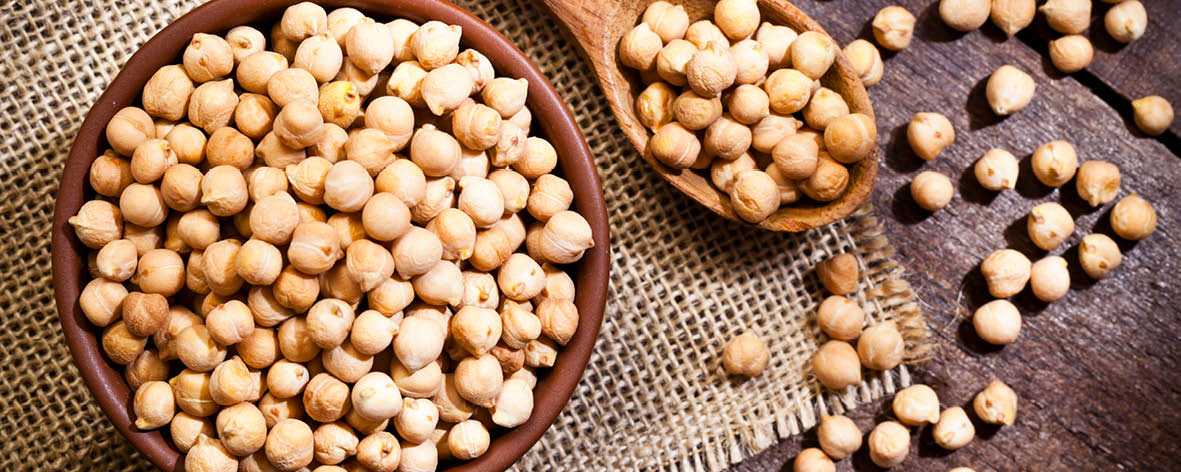All you need to know about … Chickpeas

True or false? With a few cans of chickpeas, you can make a cocktail, a dip, a main course, and dessert. Read on to find out the answer and learn the myriad ways to use this versatile legume.
It’s true! This versatile legume of the family Fabaceae has some surprising properties. It’s one of the earliest cultivated legumes dating back at least 9500 years and features in Middle Eastern and Mediterranean cuisines, and in Indian cooking too. India is responsible for 70% of worldwide chickpea production. Chickpeas are very high in protein and fibre, help stabilise blood sugar, promote cardiovascular health and are great for vegans and anyone with a gluten sensitivity. Also loaded with vitamins A, E and C, they are a tiny powerpack of nutrition. Chickpeas come dried or canned. Dried chickpeas need to be cooked for 1-2 hours. If soaked the night before, cooking time can be reduced to 30 minutes.
The Cocktail
Cans of chickpeas contain, of course, chickpeas, and the liquid which is the product of the chickpea cooking process. This is known as aquafaba and is used as an egg replacement in vegan dishes. It is also fantastic as an ingredient in cocktails where a foam is required – such as that usually created with egg white. For food safety reasons, and if vegan, many people choose not to consume raw egg, so aquafaba is an excellent alternative. For a delicious gin sour, combine 60 mL Tasmanian gin such as Lawrenny, Poltergeist, Plan B, or Knocklofty, 30 mL simple syrup (made from equal parts sugar and water simmered until sugar dissolves and then cooled), 30 mL grapefruit juice, 30 mL lemon juice and 30 mL aquafaba in a cocktail shaker with ice and shake for about 30-40 seconds until frothy. Strain into a glass and serve.
The Dip
Of course, it’s hummus. Whizz up a tin of chickpeas with a clove of garlic, a tablespoon of tahini, juice of one lemon, and a tablespoon of olive oil. Add more lemon juice or a splash of water to loosen, if needed. Serve with crunchy raw carrots, cucumbers, radishes, and some warmed flat bread. Yummy, cheap, and healthy!
The Main Course
Here the choices are many and varied. Chickpeas can be eaten cold in salads, used in vegetarian stews and curries, ground into flour and made into falafels, used in Spanish tapas recipes, in Portuguese rancho which is eaten with pasta, meat or rice, and in Algerian chakhchouka, a traditional tomato stew. Here are some recipes from our collection to inspire you:
Spiced Chickpea and Tomato Pesto Pasta
Sticky Glazed Spring Lamb with Chickpea and Olive Salad
Harissa-Spiced Creamy Tomato Soup
Israeli Couscous Salad Bowl with Orange Basil Yoghurt
Roasted Vegetables with Hummus
The Dessert
Believe it or not, the seemingly magical aquafaba can also be used as an egg white substitute in a pavlova recipe.
Chill a 400g can of coconut cream and the liquid from a 400g can of chickpeas overnight. Preheat oven to 150C and line two baking trays with baking paper. Place the chilled chickpea liquid into the bowl of a stand mixer and whisk for 8 minutes or until soft peaks form. Add 1 cup of caster sugar slowly, 1 tablespoon at a time, whisking constantly for 15 minutes or until sugar is completely dissolved. Whisk in a tablespoon of cornflour and then shape 12 individual meringues from the mixture. Reduce temperature to 100C and bake for 1 hour 15 minutes or until the meringue is dry and firm. Turn off the oven and leave meringues in the oven to cool for four hours or overnight.
Whip the coconut cream with 2 tablespoons maple syrup and one teaspoon vanilla until stiff peaks form. Decorate as you wish – sliced bananas, passionfruit and flaked coconut is just one idea.

